CNUR 860 Assignment: Statistics for Nursing Data Analysis
VerifiedAdded on 2023/01/12
|15
|2230
|59
Report
AI Summary
This report presents a statistical analysis of nursing research scenarios related to bowel function, cognitive ability, and physical activity in older adults. The analysis includes descriptive statistics (mean, standard deviation, kurtosis, skewness, range), correlation analysis, and inferential tests (t-tests) to determine the relationships between variables. Research question 1 examines the relationship between bowel irregularity and willingness to participate in social events, while research scenario 3 investigates the impact of physical activity levels on perceptions of bowel function promotion. The report explores the use of t-tests to determine significant relationships and the interpretation of p-values to conclude hypotheses. The findings suggest that cognitive ability may not significantly impact knowledge of healthy bowel function post-education, and physical activity levels do not significantly influence perceptions of bowel function. The student used bar graphs and scatter plots to visualize data and support the analysis. The assignment follows APA 5th format and adheres to the guidelines provided in the CNUR 860 course, emphasizing the importance of understanding statistical concepts for nursing practice.
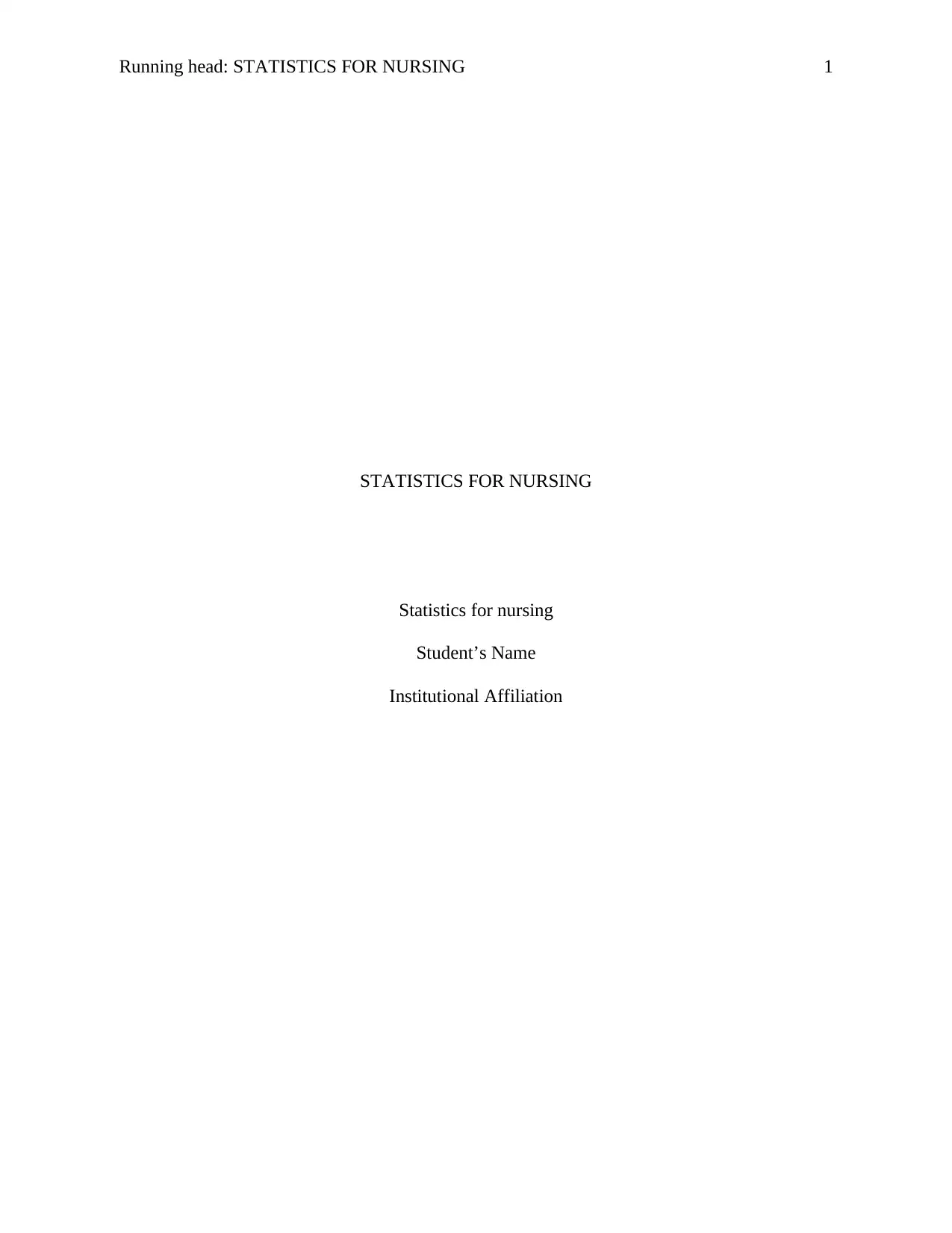
Running head: STATISTICS FOR NURSING 1
STATISTICS FOR NURSING
Statistics for nursing
Student’s Name
Institutional Affiliation
STATISTICS FOR NURSING
Statistics for nursing
Student’s Name
Institutional Affiliation
Paraphrase This Document
Need a fresh take? Get an instant paraphrase of this document with our AI Paraphraser
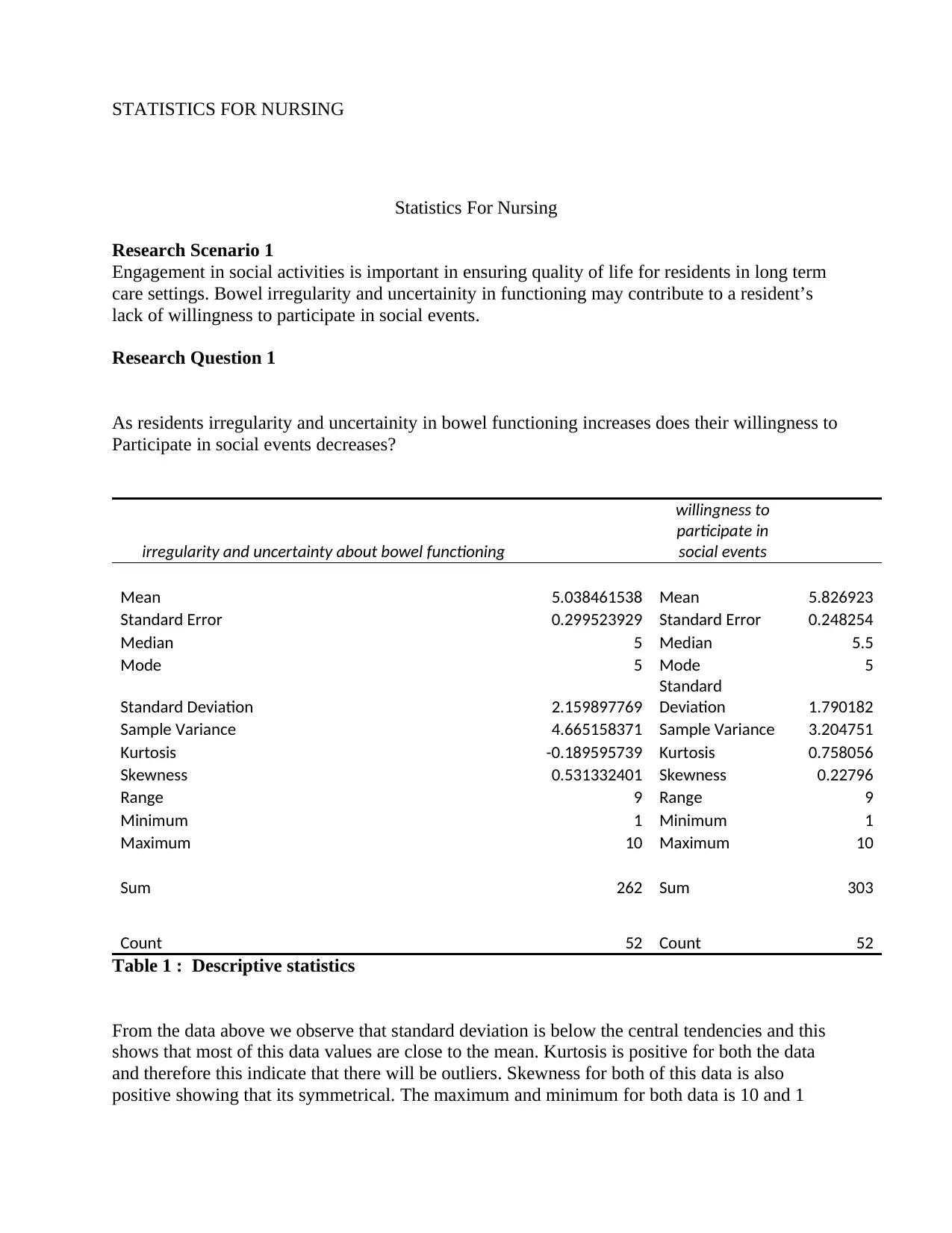
STATISTICS FOR NURSING
Statistics For Nursing
Research Scenario 1
Engagement in social activities is important in ensuring quality of life for residents in long term
care settings. Bowel irregularity and uncertainity in functioning may contribute to a resident’s
lack of willingness to participate in social events.
Research Question 1
As residents irregularity and uncertainity in bowel functioning increases does their willingness to
Participate in social events decreases?
irregularity and uncertainty about bowel functioning
willingness to
participate in
social events
Mean 5.038461538 Mean 5.826923
Standard Error 0.299523929 Standard Error 0.248254
Median 5 Median 5.5
Mode 5 Mode 5
Standard Deviation 2.159897769
Standard
Deviation 1.790182
Sample Variance 4.665158371 Sample Variance 3.204751
Kurtosis -0.189595739 Kurtosis 0.758056
Skewness 0.531332401 Skewness 0.22796
Range 9 Range 9
Minimum 1 Minimum 1
Maximum 10 Maximum 10
Sum 262 Sum 303
Count 52 Count 52
Table 1 : Descriptive statistics
From the data above we observe that standard deviation is below the central tendencies and this
shows that most of this data values are close to the mean. Kurtosis is positive for both the data
and therefore this indicate that there will be outliers. Skewness for both of this data is also
positive showing that its symmetrical. The maximum and minimum for both data is 10 and 1
Statistics For Nursing
Research Scenario 1
Engagement in social activities is important in ensuring quality of life for residents in long term
care settings. Bowel irregularity and uncertainity in functioning may contribute to a resident’s
lack of willingness to participate in social events.
Research Question 1
As residents irregularity and uncertainity in bowel functioning increases does their willingness to
Participate in social events decreases?
irregularity and uncertainty about bowel functioning
willingness to
participate in
social events
Mean 5.038461538 Mean 5.826923
Standard Error 0.299523929 Standard Error 0.248254
Median 5 Median 5.5
Mode 5 Mode 5
Standard Deviation 2.159897769
Standard
Deviation 1.790182
Sample Variance 4.665158371 Sample Variance 3.204751
Kurtosis -0.189595739 Kurtosis 0.758056
Skewness 0.531332401 Skewness 0.22796
Range 9 Range 9
Minimum 1 Minimum 1
Maximum 10 Maximum 10
Sum 262 Sum 303
Count 52 Count 52
Table 1 : Descriptive statistics
From the data above we observe that standard deviation is below the central tendencies and this
shows that most of this data values are close to the mean. Kurtosis is positive for both the data
and therefore this indicate that there will be outliers. Skewness for both of this data is also
positive showing that its symmetrical. The maximum and minimum for both data is 10 and 1
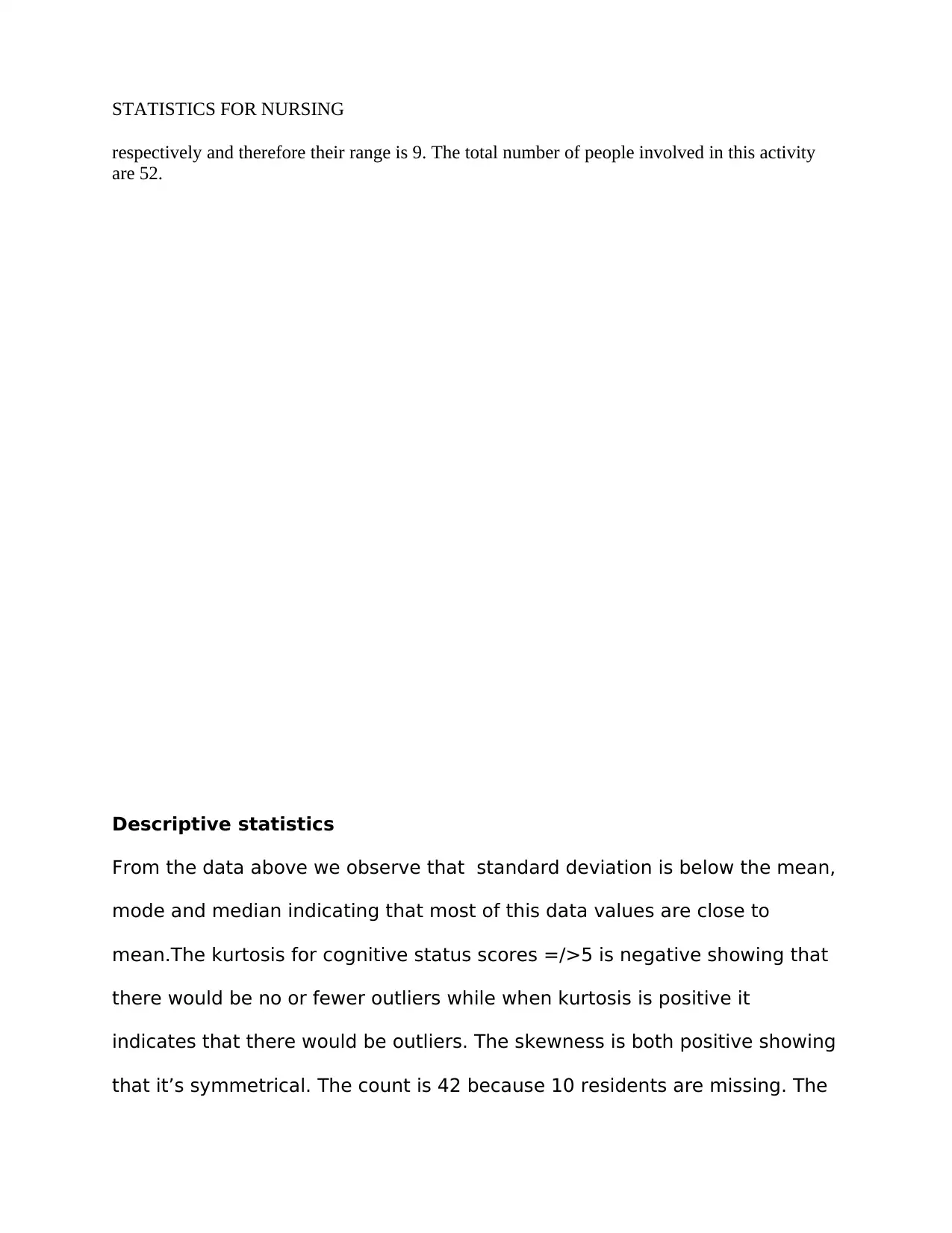
STATISTICS FOR NURSING
respectively and therefore their range is 9. The total number of people involved in this activity
are 52.
Descriptive statistics
From the data above we observe that standard deviation is below the mean,
mode and median indicating that most of this data values are close to
mean.The kurtosis for cognitive status scores =/>5 is negative showing that
there would be no or fewer outliers while when kurtosis is positive it
indicates that there would be outliers. The skewness is both positive showing
that it’s symmetrical. The count is 42 because 10 residents are missing. The
respectively and therefore their range is 9. The total number of people involved in this activity
are 52.
Descriptive statistics
From the data above we observe that standard deviation is below the mean,
mode and median indicating that most of this data values are close to
mean.The kurtosis for cognitive status scores =/>5 is negative showing that
there would be no or fewer outliers while when kurtosis is positive it
indicates that there would be outliers. The skewness is both positive showing
that it’s symmetrical. The count is 42 because 10 residents are missing. The
⊘ This is a preview!⊘
Do you want full access?
Subscribe today to unlock all pages.

Trusted by 1+ million students worldwide
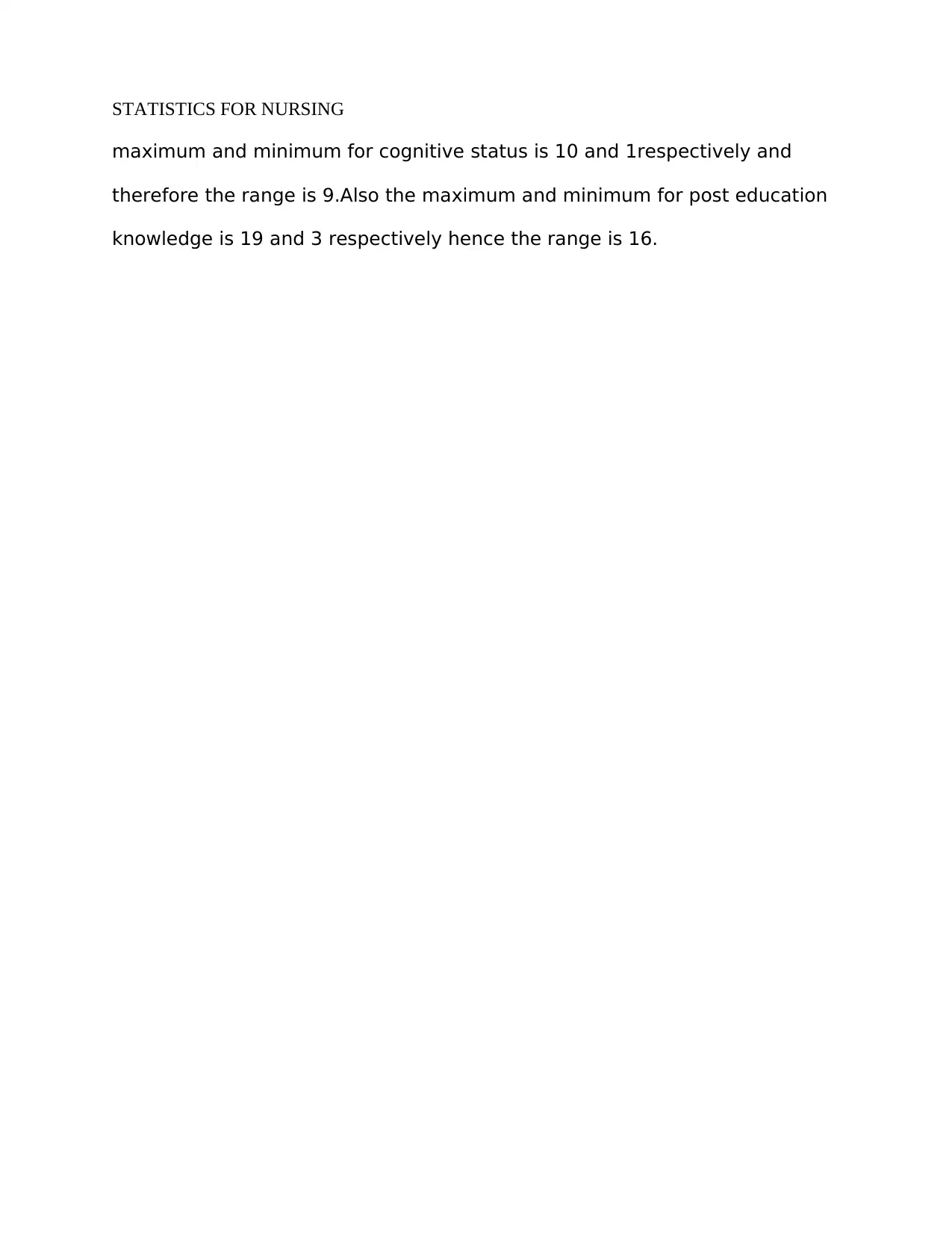
STATISTICS FOR NURSING
maximum and minimum for cognitive status is 10 and 1respectively and
therefore the range is 9.Also the maximum and minimum for post education
knowledge is 19 and 3 respectively hence the range is 16.
maximum and minimum for cognitive status is 10 and 1respectively and
therefore the range is 9.Also the maximum and minimum for post education
knowledge is 19 and 3 respectively hence the range is 16.
Paraphrase This Document
Need a fresh take? Get an instant paraphrase of this document with our AI Paraphraser
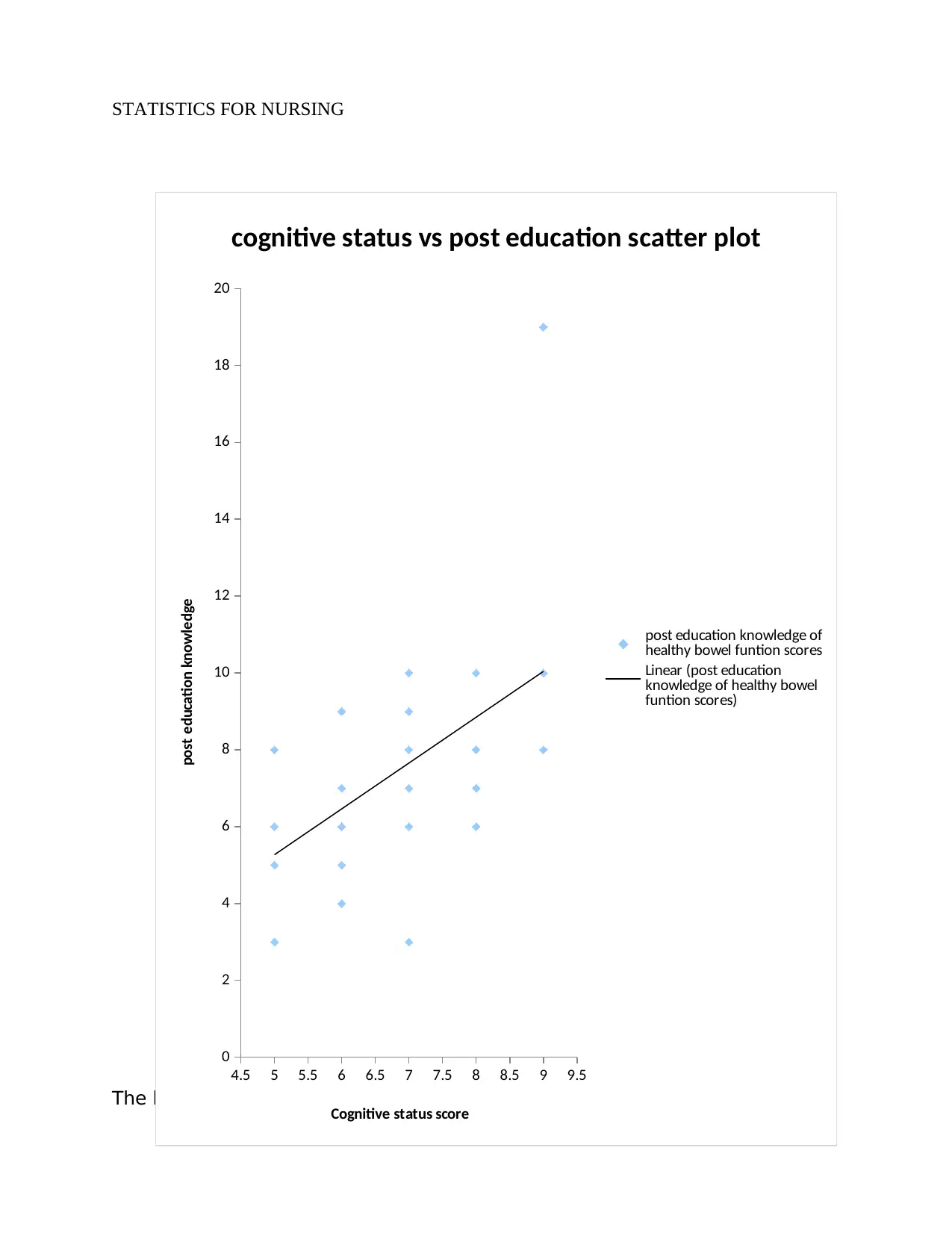
STATISTICS FOR NURSING
The bar graph of cognitive vs post education knowledge shown above.
4.5 5 5.5 6 6.5 7 7.5 8 8.5 9 9.5
0
2
4
6
8
10
12
14
16
18
20
cognitive status vs post education scatter plot
post education knowledge of
healthy bowel funtion scores
Linear (post education
knowledge of healthy bowel
funtion scores)
Cognitive status score
post education knowledge
The bar graph of cognitive vs post education knowledge shown above.
4.5 5 5.5 6 6.5 7 7.5 8 8.5 9 9.5
0
2
4
6
8
10
12
14
16
18
20
cognitive status vs post education scatter plot
post education knowledge of
healthy bowel funtion scores
Linear (post education
knowledge of healthy bowel
funtion scores)
Cognitive status score
post education knowledge
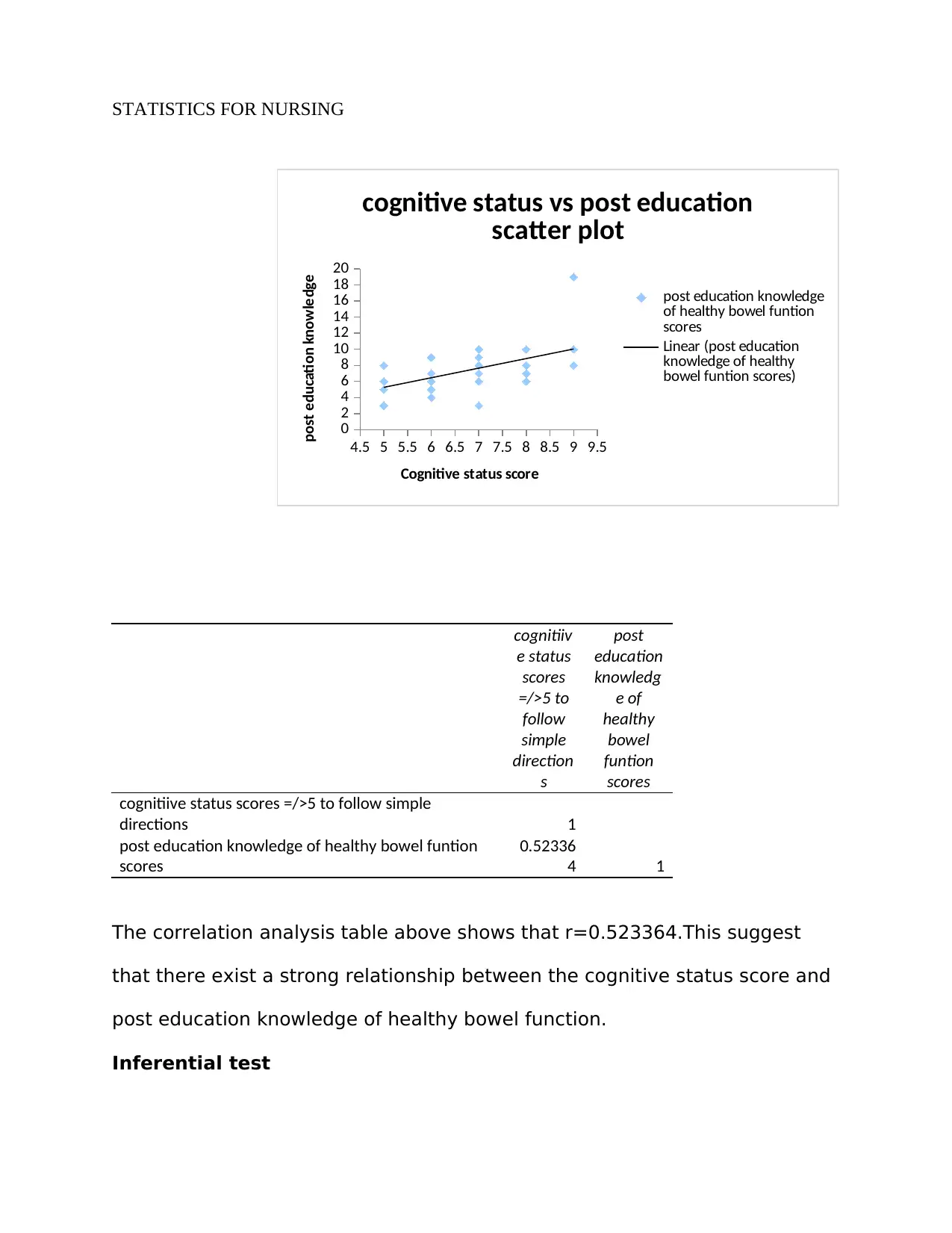
STATISTICS FOR NURSING
cognitiiv
e status
scores
=/>5 to
follow
simple
direction
s
post
education
knowledg
e of
healthy
bowel
funtion
scores
cognitiive status scores =/>5 to follow simple
directions 1
post education knowledge of healthy bowel funtion
scores
0.52336
4 1
The correlation analysis table above shows that r=0.523364.This suggest
that there exist a strong relationship between the cognitive status score and
post education knowledge of healthy bowel function.
Inferential test
4.5 5 5.5 6 6.5 7 7.5 8 8.5 9 9.5
0
2
4
6
8
10
12
14
16
18
20
cognitive status vs post education
scatter plot
post education knowledge
of healthy bowel funtion
scores
Linear (post education
knowledge of healthy
bowel funtion scores)
Cognitive status score
post education knowledge
cognitiiv
e status
scores
=/>5 to
follow
simple
direction
s
post
education
knowledg
e of
healthy
bowel
funtion
scores
cognitiive status scores =/>5 to follow simple
directions 1
post education knowledge of healthy bowel funtion
scores
0.52336
4 1
The correlation analysis table above shows that r=0.523364.This suggest
that there exist a strong relationship between the cognitive status score and
post education knowledge of healthy bowel function.
Inferential test
4.5 5 5.5 6 6.5 7 7.5 8 8.5 9 9.5
0
2
4
6
8
10
12
14
16
18
20
cognitive status vs post education
scatter plot
post education knowledge
of healthy bowel funtion
scores
Linear (post education
knowledge of healthy
bowel funtion scores)
Cognitive status score
post education knowledge
⊘ This is a preview!⊘
Do you want full access?
Subscribe today to unlock all pages.

Trusted by 1+ million students worldwide
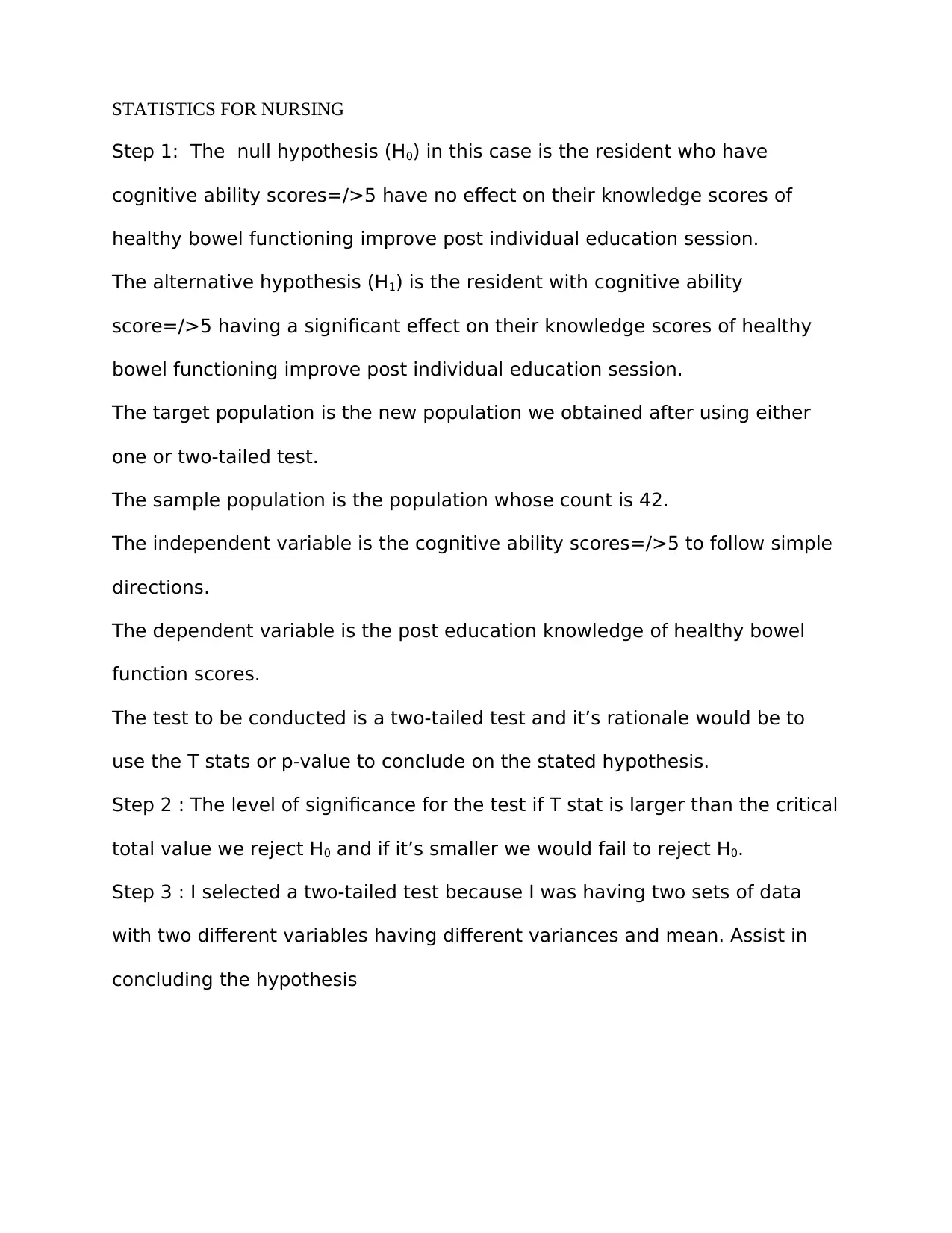
STATISTICS FOR NURSING
Step 1: The null hypothesis (H0) in this case is the resident who have
cognitive ability scores=/>5 have no effect on their knowledge scores of
healthy bowel functioning improve post individual education session.
The alternative hypothesis (H1) is the resident with cognitive ability
score=/>5 having a significant effect on their knowledge scores of healthy
bowel functioning improve post individual education session.
The target population is the new population we obtained after using either
one or two-tailed test.
The sample population is the population whose count is 42.
The independent variable is the cognitive ability scores=/>5 to follow simple
directions.
The dependent variable is the post education knowledge of healthy bowel
function scores.
The test to be conducted is a two-tailed test and it’s rationale would be to
use the T stats or p-value to conclude on the stated hypothesis.
Step 2 : The level of significance for the test if T stat is larger than the critical
total value we reject H0 and if it’s smaller we would fail to reject H0.
Step 3 : I selected a two-tailed test because I was having two sets of data
with two different variables having different variances and mean. Assist in
concluding the hypothesis
Step 1: The null hypothesis (H0) in this case is the resident who have
cognitive ability scores=/>5 have no effect on their knowledge scores of
healthy bowel functioning improve post individual education session.
The alternative hypothesis (H1) is the resident with cognitive ability
score=/>5 having a significant effect on their knowledge scores of healthy
bowel functioning improve post individual education session.
The target population is the new population we obtained after using either
one or two-tailed test.
The sample population is the population whose count is 42.
The independent variable is the cognitive ability scores=/>5 to follow simple
directions.
The dependent variable is the post education knowledge of healthy bowel
function scores.
The test to be conducted is a two-tailed test and it’s rationale would be to
use the T stats or p-value to conclude on the stated hypothesis.
Step 2 : The level of significance for the test if T stat is larger than the critical
total value we reject H0 and if it’s smaller we would fail to reject H0.
Step 3 : I selected a two-tailed test because I was having two sets of data
with two different variables having different variances and mean. Assist in
concluding the hypothesis
Paraphrase This Document
Need a fresh take? Get an instant paraphrase of this document with our AI Paraphraser
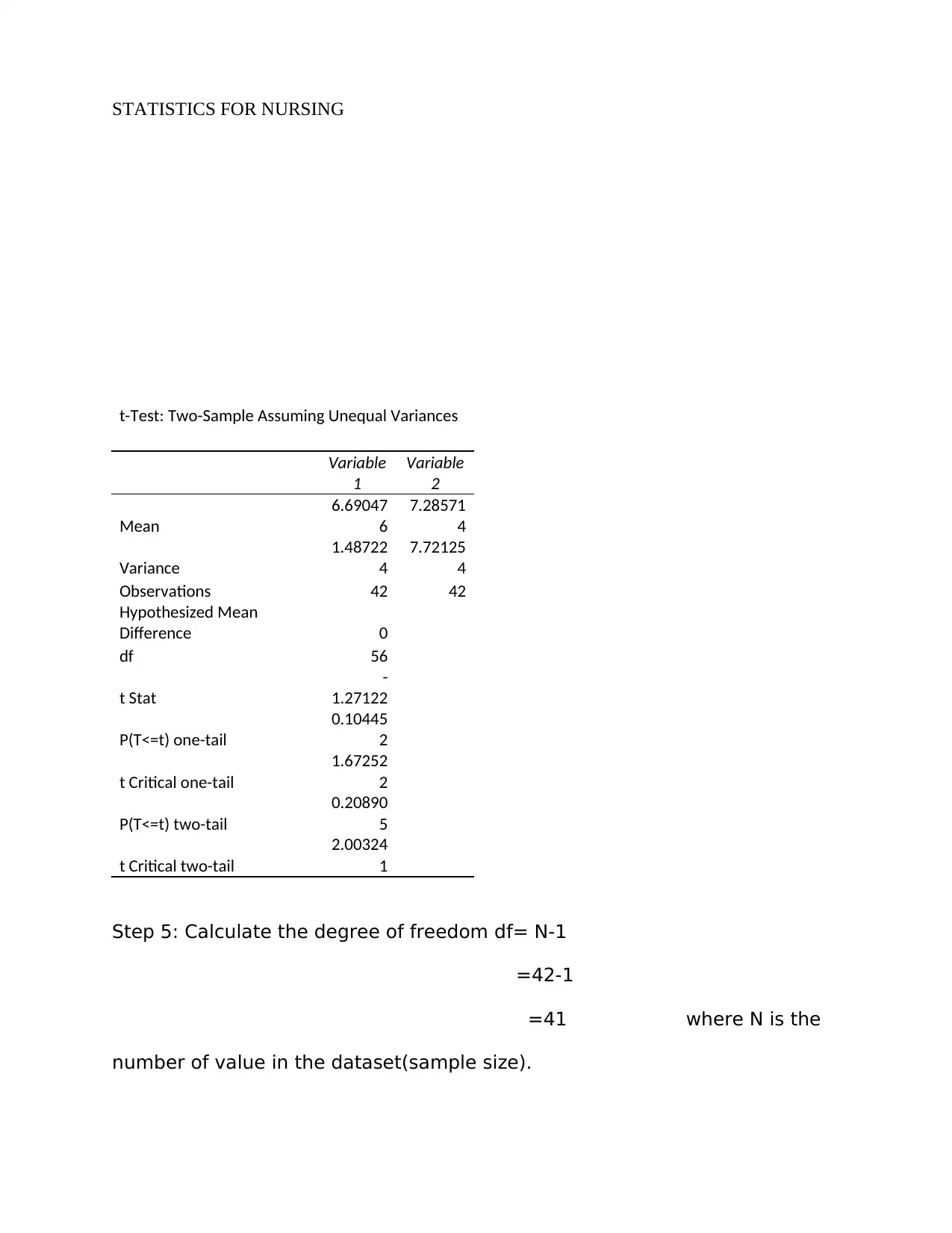
STATISTICS FOR NURSING
t-Test: Two-Sample Assuming Unequal Variances
Variable
1
Variable
2
Mean
6.69047
6
7.28571
4
Variance
1.48722
4
7.72125
4
Observations 42 42
Hypothesized Mean
Difference 0
df 56
t Stat
-
1.27122
P(T<=t) one-tail
0.10445
2
t Critical one-tail
1.67252
2
P(T<=t) two-tail
0.20890
5
t Critical two-tail
2.00324
1
Step 5: Calculate the degree of freedom df= N-1
=42-1
=41 where N is the
number of value in the dataset(sample size).
t-Test: Two-Sample Assuming Unequal Variances
Variable
1
Variable
2
Mean
6.69047
6
7.28571
4
Variance
1.48722
4
7.72125
4
Observations 42 42
Hypothesized Mean
Difference 0
df 56
t Stat
-
1.27122
P(T<=t) one-tail
0.10445
2
t Critical one-tail
1.67252
2
P(T<=t) two-tail
0.20890
5
t Critical two-tail
2.00324
1
Step 5: Calculate the degree of freedom df= N-1
=42-1
=41 where N is the
number of value in the dataset(sample size).
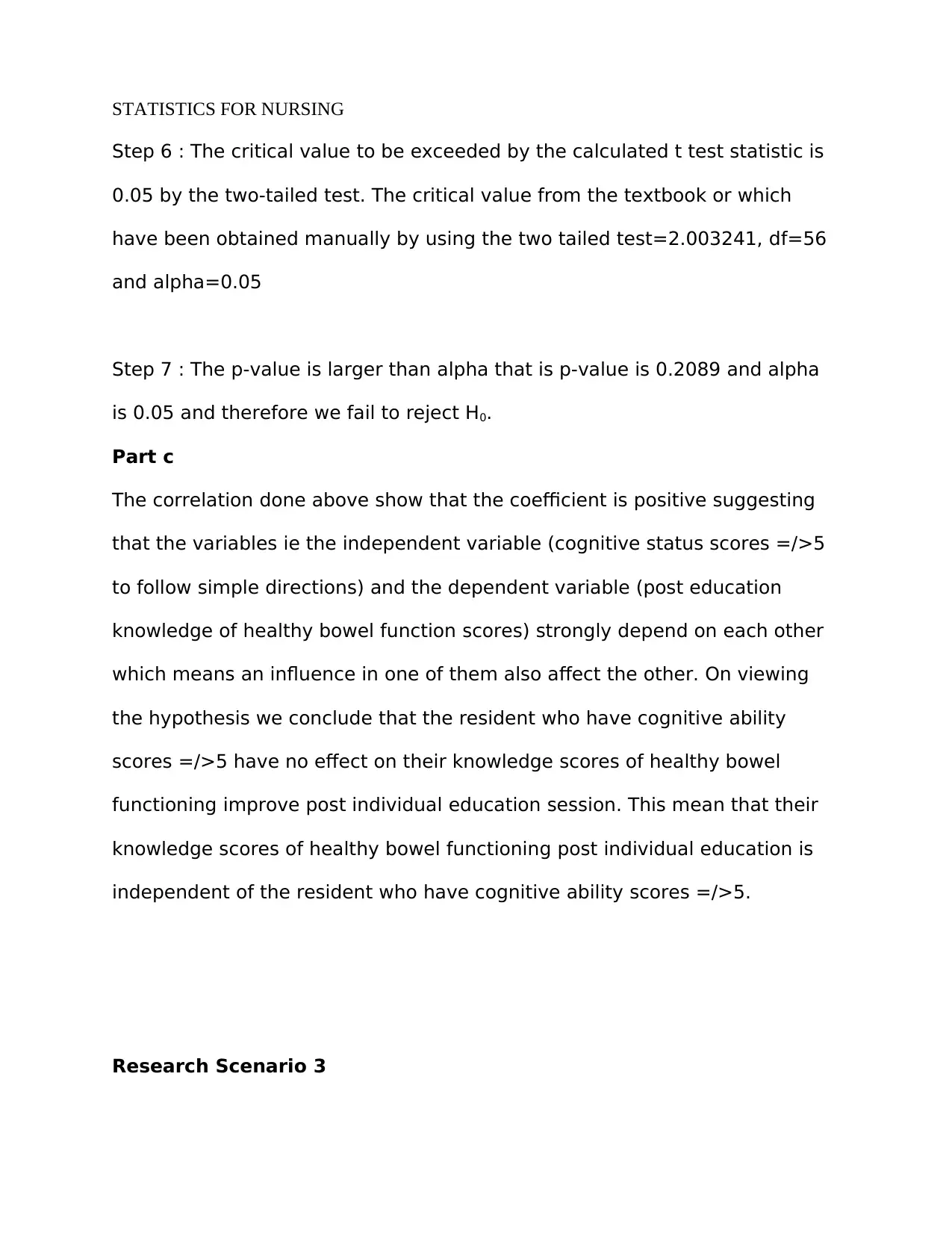
STATISTICS FOR NURSING
Step 6 : The critical value to be exceeded by the calculated t test statistic is
0.05 by the two-tailed test. The critical value from the textbook or which
have been obtained manually by using the two tailed test=2.003241, df=56
and alpha=0.05
Step 7 : The p-value is larger than alpha that is p-value is 0.2089 and alpha
is 0.05 and therefore we fail to reject H0.
Part c
The correlation done above show that the coefficient is positive suggesting
that the variables ie the independent variable (cognitive status scores =/>5
to follow simple directions) and the dependent variable (post education
knowledge of healthy bowel function scores) strongly depend on each other
which means an influence in one of them also affect the other. On viewing
the hypothesis we conclude that the resident who have cognitive ability
scores =/>5 have no effect on their knowledge scores of healthy bowel
functioning improve post individual education session. This mean that their
knowledge scores of healthy bowel functioning post individual education is
independent of the resident who have cognitive ability scores =/>5.
Research Scenario 3
Step 6 : The critical value to be exceeded by the calculated t test statistic is
0.05 by the two-tailed test. The critical value from the textbook or which
have been obtained manually by using the two tailed test=2.003241, df=56
and alpha=0.05
Step 7 : The p-value is larger than alpha that is p-value is 0.2089 and alpha
is 0.05 and therefore we fail to reject H0.
Part c
The correlation done above show that the coefficient is positive suggesting
that the variables ie the independent variable (cognitive status scores =/>5
to follow simple directions) and the dependent variable (post education
knowledge of healthy bowel function scores) strongly depend on each other
which means an influence in one of them also affect the other. On viewing
the hypothesis we conclude that the resident who have cognitive ability
scores =/>5 have no effect on their knowledge scores of healthy bowel
functioning improve post individual education session. This mean that their
knowledge scores of healthy bowel functioning post individual education is
independent of the resident who have cognitive ability scores =/>5.
Research Scenario 3
⊘ This is a preview!⊘
Do you want full access?
Subscribe today to unlock all pages.

Trusted by 1+ million students worldwide
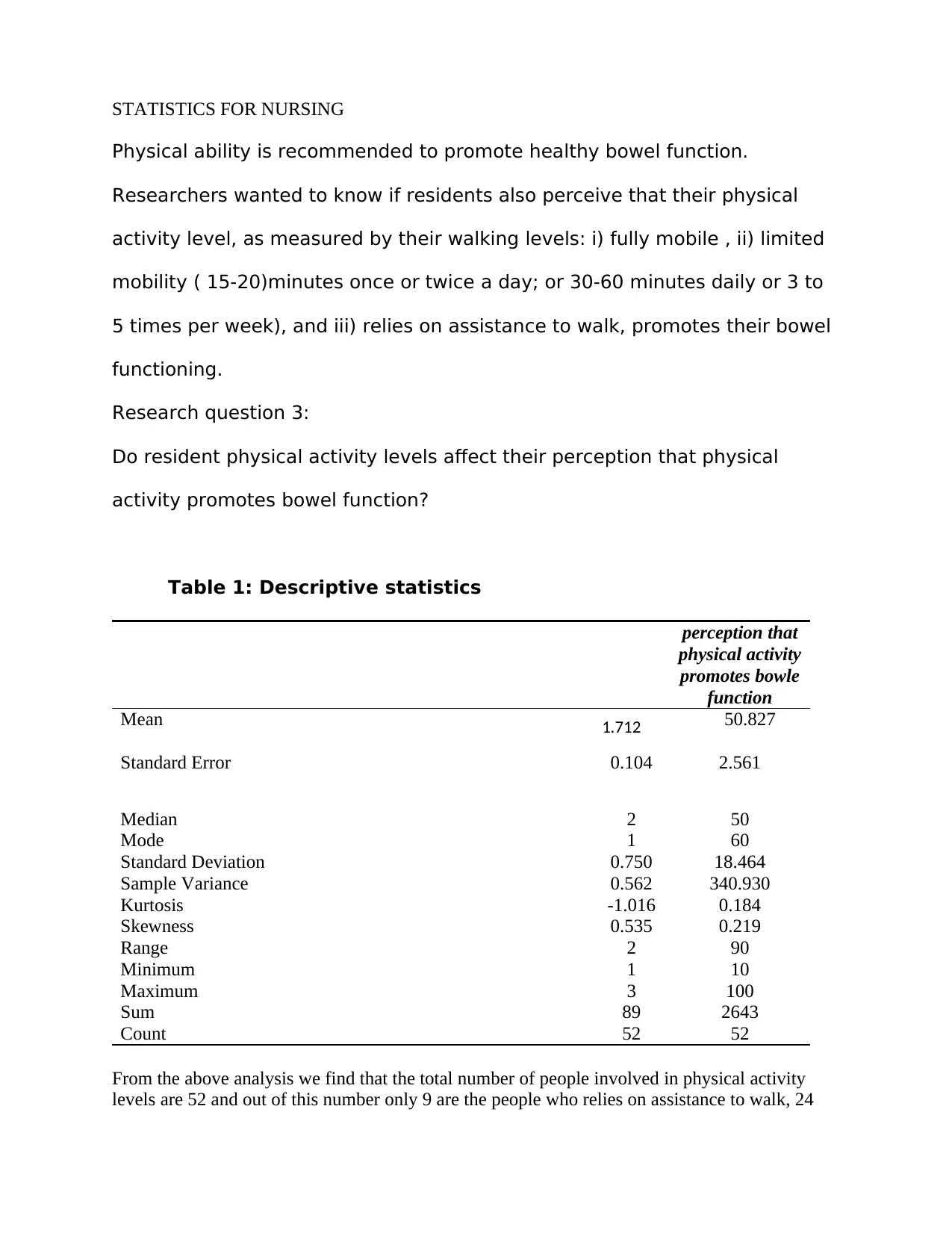
STATISTICS FOR NURSING
Physical ability is recommended to promote healthy bowel function.
Researchers wanted to know if residents also perceive that their physical
activity level, as measured by their walking levels: i) fully mobile , ii) limited
mobility ( 15-20)minutes once or twice a day; or 30-60 minutes daily or 3 to
5 times per week), and iii) relies on assistance to walk, promotes their bowel
functioning.
Research question 3:
Do resident physical activity levels affect their perception that physical
activity promotes bowel function?
Table 1: Descriptive statistics
perception that
physical activity
promotes bowle
function
Mean 1.712 50.827
Standard Error 0.104 2.561
Median 2 50
Mode 1 60
Standard Deviation 0.750 18.464
Sample Variance 0.562 340.930
Kurtosis -1.016 0.184
Skewness 0.535 0.219
Range 2 90
Minimum 1 10
Maximum 3 100
Sum 89 2643
Count 52 52
From the above analysis we find that the total number of people involved in physical activity
levels are 52 and out of this number only 9 are the people who relies on assistance to walk, 24
Physical ability is recommended to promote healthy bowel function.
Researchers wanted to know if residents also perceive that their physical
activity level, as measured by their walking levels: i) fully mobile , ii) limited
mobility ( 15-20)minutes once or twice a day; or 30-60 minutes daily or 3 to
5 times per week), and iii) relies on assistance to walk, promotes their bowel
functioning.
Research question 3:
Do resident physical activity levels affect their perception that physical
activity promotes bowel function?
Table 1: Descriptive statistics
perception that
physical activity
promotes bowle
function
Mean 1.712 50.827
Standard Error 0.104 2.561
Median 2 50
Mode 1 60
Standard Deviation 0.750 18.464
Sample Variance 0.562 340.930
Kurtosis -1.016 0.184
Skewness 0.535 0.219
Range 2 90
Minimum 1 10
Maximum 3 100
Sum 89 2643
Count 52 52
From the above analysis we find that the total number of people involved in physical activity
levels are 52 and out of this number only 9 are the people who relies on assistance to walk, 24
Paraphrase This Document
Need a fresh take? Get an instant paraphrase of this document with our AI Paraphraser

STATISTICS FOR NURSING
have full mobility and 19 have limited mobility. Using this data we can get their respective
proportion out of all the people who participated in the activity, their proportion is as follows;
17.3% is for those who need assistance to walk, 46.2% those who have full mobility and 36.5%
those with limited mobility. Now on the perception that physical activity promote bowel function
we observe from the analysis that the maximum is 100 and the minimum is 10 hence from that
we get the range which is 90. The central tendencies that is the mean, mode and median are close
to each other showing that the data is well distributed. The kurtosis is negative for physical
activity suggesting that there would be few or no outliers. We also observe that the standard
deviation was lower as compared to mode, mean and median. Furthermore the skewness is
positive showing that the data is symmetrical.
1 2 3
0
5
10
15
20
25
30
24
19
9
Activity Level
activity level
Activity
Frequency
Figure 1: Activity Level Bar Graph
have full mobility and 19 have limited mobility. Using this data we can get their respective
proportion out of all the people who participated in the activity, their proportion is as follows;
17.3% is for those who need assistance to walk, 46.2% those who have full mobility and 36.5%
those with limited mobility. Now on the perception that physical activity promote bowel function
we observe from the analysis that the maximum is 100 and the minimum is 10 hence from that
we get the range which is 90. The central tendencies that is the mean, mode and median are close
to each other showing that the data is well distributed. The kurtosis is negative for physical
activity suggesting that there would be few or no outliers. We also observe that the standard
deviation was lower as compared to mode, mean and median. Furthermore the skewness is
positive showing that the data is symmetrical.
1 2 3
0
5
10
15
20
25
30
24
19
9
Activity Level
activity level
Activity
Frequency
Figure 1: Activity Level Bar Graph

STATISTICS FOR NURSING
10 20 25 30 32 33 35 38 40 44 45 47 50 53 55 56 57 60 65 66 67 70 74 75 76 79 80 90100
0
1
2
3
4
5
6
7
Perception that physical activity promotes bowle function
Series1
Perceptions
Frequency
Figure 2: Perceptions Bar Graph.
Inferential Statistics
0.5 1 1.5 2 2.5 3 3.5
0
20
40
60
80
100
120
f(x) = − 1.62508383635144 x + 53.608316566063
R² = 0.00435501985349696
Perception that physical activity promotes bowle function
perception that physical activity
promotes bowle function
Linear (perception that physical
activity promotes bowle
function)
Figure 3: Physical Activity and Perception Scatter plot
10 20 25 30 32 33 35 38 40 44 45 47 50 53 55 56 57 60 65 66 67 70 74 75 76 79 80 90100
0
1
2
3
4
5
6
7
Perception that physical activity promotes bowle function
Series1
Perceptions
Frequency
Figure 2: Perceptions Bar Graph.
Inferential Statistics
0.5 1 1.5 2 2.5 3 3.5
0
20
40
60
80
100
120
f(x) = − 1.62508383635144 x + 53.608316566063
R² = 0.00435501985349696
Perception that physical activity promotes bowle function
perception that physical activity
promotes bowle function
Linear (perception that physical
activity promotes bowle
function)
Figure 3: Physical Activity and Perception Scatter plot
⊘ This is a preview!⊘
Do you want full access?
Subscribe today to unlock all pages.

Trusted by 1+ million students worldwide
1 out of 15
Related Documents
Your All-in-One AI-Powered Toolkit for Academic Success.
+13062052269
info@desklib.com
Available 24*7 on WhatsApp / Email
![[object Object]](/_next/static/media/star-bottom.7253800d.svg)
Unlock your academic potential
Copyright © 2020–2025 A2Z Services. All Rights Reserved. Developed and managed by ZUCOL.




